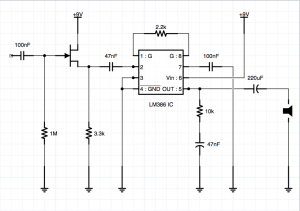I have been playing with some various circuits to deal with the pre amp stages and effects loops for my miniature guitar amplifier design. The circuit presented here is a revision of my previous core amplifier schematics. Other than a few component changes, the main difference is that I have added an N-FET transistor (MPF102) buffer to the input stage. This should prevent improper impedance loading on any pedals in the effects loop stage which precedes it.
I may make further modifications, such as replacing the 47nF capacitor on the input signal (pin #2 of the LM386N-1 chip) to see what effect that has with different and higher values. Although I have been using op amps for the input stage buffers and pre amp circuits for the past week, I felt that the FET buffer would impart a nicer tone than the 741 chip – I might be imagining it, but it sounds like it’s helping.
One note on the choice of LM386N-1 chip – much to my chagrin I discovered this week that not all are created equal. I have one made by National Semiconductor which I believe was purchased at the local RadioShack in the 1990’s, while they still had operations in Canada. The other models of the chip I have were made more recently and purchased at another local electronics parts store. The older chip amplifies loud and clear with little distortion, even with a slight additional gain introduced by having the 2.2k resistor between pins 1 and 8.
The other LM386 chips I have on hand are another story – they break up and distort on higher frequency notes and even when pushed with more power (12V instead of 9V) they don’t behave much better. Removing the extra gain boost resistor does not resolve the issue either, these chips are just no good for this purpose.
I have spent a fair bit of time fighting that chip-induced distortion, thinking it was a fault in my circuit implementation. It wasn’t until I randomly swapped in the older chip that I realized the root cause of the trouble. I have on order some JRC-386D ICs which I have read are a better implementation of the LM386 design. They are rated at a full 500mW unlike the wimpy LM386-N1 chips I’ve been testing with.
One other thing I have been experimenting with is adding a further stage after the power amp pictured above, using a pair of matched transistors as a Push-Pull amplifier to double the output wattage to a full 1W. My first attempts actually seemed to introduce distortion and attenuate the output which was naturally not the desired effect, although it was a nice distortion sound so that might have some future promise in a dirt pedal design.




No Responses to “Miniature Guitar Amplifier – Revised Power Amp”
Trackbacks/Pingbacks